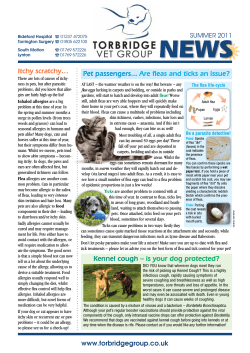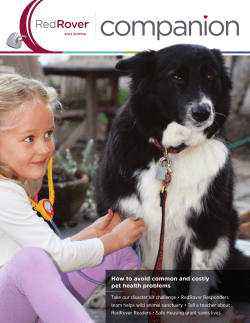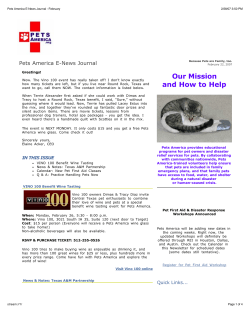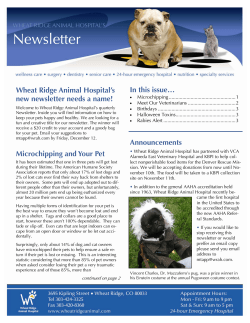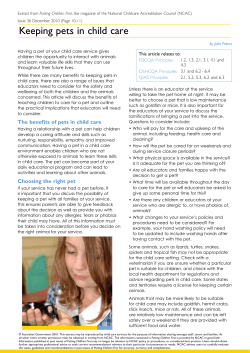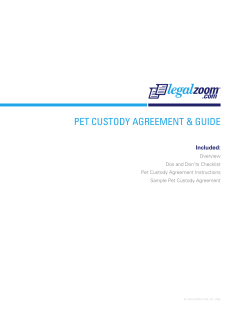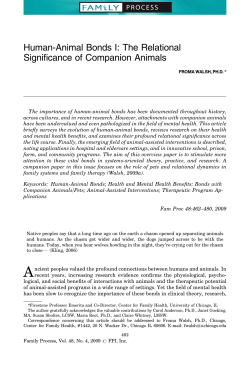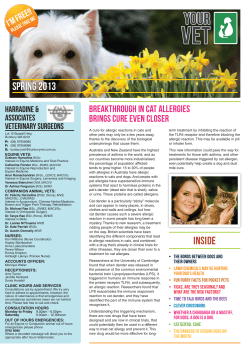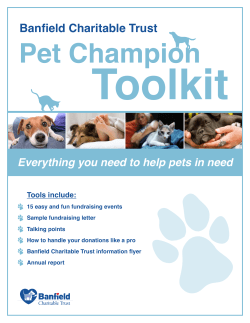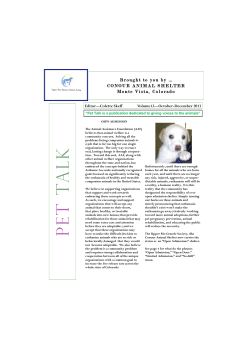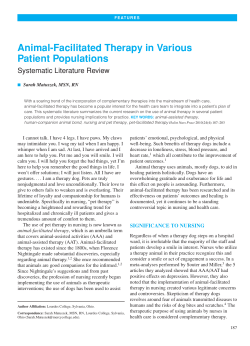
1 Wilson, CC. (1991). The pet as an anxiolytic intervention. ... Nerv and Ment Disease 179:482-489.
WORKS CITED 1 2 3 4 5 6 7 8 9 10 11 12 13 14 15 16 17 18 19 20 21 22 23 24 25 Wilson, CC. (1991). The pet as an anxiolytic intervention. J Nerv and Ment Disease 179:482-489. Allen, K. (2001). Pet ownership, but Not ACE Inhibitor Therapy, Blunts Home Blood Pressure Response. Hypertension. 2001;38:815. Friedmann, E., and Thomas, S.A. (1995). Pet ownership, social support and one year survival amoung post-mycardial infarction patients in the cardiac arrhythmia suppression trial (CAST). Am J Cardiology 76:1213-1217. Anderson, W.P., Reid, C.M., Jennings, G.L. (1992). Pet ownership and risk factors for cardiovascular disease. Medical Journal of Australia 157:298-301 Eddy, T.J. (1996). RM and Beaux: reduction in cardiac response in response to a pet snake. J Nerv and Ment Disease 184(9):573-575. Friedmann, E., Katcher, A.H., Thomas, S.A., Lynch, J.J., Messent, P.R. (1983). Social interaction and blood pressure: Influence of animal companions. J Nerv and Ment Disease 171(8):461-465. Katcher, A.H., Friedmann, Beck, A.M., Lynch, J. (1983). Looking, talking and blood pressure: The physiologic consequences of interaction with the living environment. In: New Perspectives on Our Lives with Companion Animals (AH Katcher, AM Beck, eds) 1983 (p. 351). Allen, K.M., Blascovich, J. (2002). Cardiovascular reactivity and the presence of pets, friends and spouses: the truth about cats and dogs. Psychosomatic Medicine 64:727-739. DeSchriver, M.M., Riddick, C.C. (1990). Effects of watching aquariums on elders' stress. Anthrozoos 4(1):44-48. Odendaal, J. (2000). Animal-assisted therapy - magic or medicine? J Psychosomatic Research 49(4):275-280. Barker, S., Knisely, J., McCain, N., Best, A. 2005. Measuring Stress and immune response in healthcare professionsal following interaction with a therapy dog: pilot study. Psychologic Reports 96:713-729. Gern, J., Reasdon, C., Hoffjan, S., Li, Z., Rogberg, K., Neaville, W., Carlson-Dakes, K., Alder, K., Hamilton, R., Anderson, E., Gilbertson White, S., Tisler, C., Dasilva, D., Anklam, K., Mikus, L., Rosenthal, L., Ober, C., Gangon, R., Lemanske, R. (2004). Effects of dog ownership and genotype on immune development and atopy in infancy. J Clinical Immunology. 113(2):307-314. Celedón, J., Litonjura, A., Weiss, S., Gold, R. (2002). Exposure to cat allergen, maternal history of asthma, and wheezing in the first 5 years of life. The Lancet 360:781-782. Oberle, D., von Mutius, E., von Kries, R. (2003). Childhood asthma and continuous exposure to cats since the first year of life with cats allowed in the child's bedroom. Allergy 58(10):1033-1036. Svanes, C. Heinrich, J., Jarvis, D., Chinn, S., Omenaas, E., Gulsvik, A., Kunzli, N., Burney, P. (2003). Pet-keeping in childhood and adult asthma and hay fever. J Allergy Clinical Immunology 112(2):263-264 Hesselmar, B., Aberg, N., Aberg, B., Ericksson, B., Bjorksten, B. (1999). Does early exposure to cat or dog protect against later allergy development? Clinical Experimental Allergy 29:611-617 De Meer, G., Toelle, B., Ng, K., Tovey, E., Marks, G. (2004). Presence and timing of cat ownership by age 18 and the effect on atopy and asthma at age 28. Journal of Allergy Clinical Immunology 113(3):433-438. Charnetski CJ., Riggers S. (2004). Effect of petting a dog on immune system function. Psychological reports 95:10871091. Irani, S., Mahler C., Goetzman L., Russi EW., Boehler, A. (2006). Lung transplant recipients holding companion animals: impact on physical health and quality of life. Am J Transplant. 6(2):404-11. Sobo. E., Eng, B., Kassity-Krich, N. (2006). Canine Visitation Therapy Pilot Data on Decreases in Child Pain Perception. J of Holistic Nursing, Vol. 24 (1) 2006; 51-57. Serpell, J.A. (1990). Evidence for long term effects of pet ownership on human health. In: Pets, Benefits and Practice. Waltham Symposium 20. (IH Burger, ed) (p. 1-7), BVA Publications. Siegel, J.M. (1990). Stressful life events and use of physicians' services among the elderly: the moderating role of pet ownership. J Pers Soc Psychol 58:1081-1086. Straede, C., Gates, G. 1993. Psychological Health in a Population of Australian Cat Owners. Anthrozoos 6:30-41. Barker, S., Barker, R. 1988. The Human-canine bond: Closer than family ties. Journal of Mental Health Counseling 10:4656. Akiyama, H., Holtzman, J., Britz, W. (1986). Pet ownership and health status during bereavement. Omega 17(21):187-193. 26 Garrity, T.F., Stallones, L., Marx, M.B., Johnson, T.P. (1989). Pet ownership and attachment as supportive factors in health of the elderly. Anthrozoos 3(1):35-44. 27 Carmack, B.J. (1991). The role of companion animals for persons with AIDS/HIV. Holistic Nurs Pract 5(2):24-31. 28 Castelli, P., Zasloff, R.L. (2001). Companion cats and the social system of men with AIDS. Psych Reports 89:177187. 29 Siegel, J.M., Angulo, F.J., Detels, R., Wesch, J., Mullen, A. (1999). AIDS diagnosis and depression in the Multicenter AIDS Cohort Study: The ameliorating impact of pet ownership. AIDS Care 11:157-169. 30 Kidd, A., Kidd, R. (1994). Benefits and liabilities of pets for the homeless. Psych Reports 74:715-722. 31 Singer, R.S., Hart, L., Zasloff, R. (1995). Dilemmas associated with rehousing homeless people who have companion animals. Psych Reports 77:851-857. 32 Rew, L. (2000). Friends and pets as companions: strategies for coping with loneliness among homeless youth. J Child and Adolescent Psych Nurs 13(3):125. 33 Valentine, D.P., Kiddoo, M., LaFleur, B. (1993). Psychosocial implications of service dog ownership for people who have mobility or hearing impairments. Soc Work Health Care 1993;19(1):109-25. 34 Kirton, A., Wirrell, E., Zhang, J., Hamiwka, L. (2004). Seizure-alerting and -response behaviors in dogs living with epileptic children. Neurology 2004;62:2303-2305. 35 Lockwood, R. 1983. The influence of animals on social perception. New Perspectives on Our lives with Companion Animals. Philadelphia: Univ Pennsylvania Press. 8:6471. 36 Blue, G.F. (1986). The Value of Pets in Children's Lives. Childhood Education, 63(2):84-90. 37 Martin, F., Farnum, J. (2002). Animal Assisted therapy for children with pervasive developmental disorders. Western Journal of Nursing Research 24(6):657-670. 38 Fritz, C.L., Farver, T.B., Kass, P.H., Hart, L.A. (1995). Association with companion animals and the expression of noncognitive symptoms in Alzheimer's patients. J Nerv and Ment Disease 183(7):459-463. 39 Flynn, C. (2000). Battered women and their animal companions: Symbolic interaction between human and nonhuman animals. Society & Animals, 8(2) 99-127. 40 Barker, S., Barker, R. 1988. The Human-canine bond: Closer than family ties. Journal of Mental Health Counseling 10:46-56. 41 All, Ac., Crane, LL., Loving, GL. (1999). Animals, Horseback Riding and Implications for Rehabilitation Therapy. Journal of Rehabilitation, 65(3():49-57. 42 Crowly-Robinson, P., Blackshaw, J.K. (1008). Pet ownership and health status of elderly in the community. Anthrozoos, 11(3):pp168-171. 43 Hart, L. (1987). Socializing effects of service dogs for people with disabilities. Anthrozoos 1(1):41-44. 44 Eddy, T.J., Hart, L., Boltz, R.P. (1988). The effects of service dogs on social acknowledgements of people in wheelchairs. Journal of Psychology 122(1)39-45. 45 Allen, K., Blascovich, J. (1996). The value of service dogs for people with severe ambulatory disabilities: a randomized controlled trial. JAMA 275(13):1001-1006. 46 McCabe, B.W., Baun, M.M., Speich, D., Agrawal, S. (2002). Resident dog in alzheimer's special care unit. Western Journal of Nursing Research 24(6):684-696. 47 Beyersdorfer and Birkenhauer (1990) Am J Alzheimer's Care and Related Disorders and Research 5:13-17. 48 Edwards, N., Beck, A.M. (2002). Animal-assisted therapy and nutrition in Alzheimer's disease. Western J Nurs Res 24(6):697-712 49 Banks, M., Banks, W. 2002. The effects of animal-assisted therapy on loneliness in an elderly population in longterm care facilities. Journal of Gerontology: Medical Sciences, 57A:428-432 50 Barker, S.B., Pandurangi, A.K., & Best, A.M. (2003) Effects of animal-assisted therapy on patients' anxiety, fear, and depression before ECT. Journal of ECT 19(1), 38-44. 51 Barak, Y., Savorai, O., Mavashev, S., Beni, A. (2001). Animal-assisted therapy for elderly schizophrenic patients: a one-year controlled trial. Am J Geriatr Pyschiatry. 9(4):439-42. 52 Fact sheet: Industry Statistics and Trends. American Pet Products Manufacturing Association, Inc. 2005/2006 Pet Owners Survey. Retrieved June 29, 2005 from: http://www.appma.org/press_industrytrends.asp. 53 Conti, L., Lieb, S., Liberti, T., Wiley-Bayless, M., Hepburn, K., Diaz, T. (1995). Pet ownership among persons with AIDS in three Florida counties. Am J Public Health. 85:1559-1561. The Health Benefits of Companion Animals INTRODUCTION If I have further questions who can I contact? Human-animal bond Many people intuitively believe that they and others derive health benefits from relationships with their animal companions, and numerous scientific studies performed over the past 25 years support this belief. Among other benefits, animals have been demonstrated to improve human cardiovascular health, reduce stress, decrease loneliness and depression, and facilitate social interactions among people who choose to have pets. Additionally, many terminally ill, pregnant, or immunocompromised people are urged to relinquish their animal companions due to concerns about zoonoses (diseases that may be transmitted between humans and non-human animals). However, giving up their beloved friends may have a detrimental, rather than beneficial, effect on their overall health. In many instances, human health professionals can contribute to the welfare of their Pets Are Wonderful Support 645 Harrison Street, Suite 100 San Francisco, CA 94107 www.pawssf.org Phone: 415.979.9550 Fax: 415.979.9269 Email: info@pawssf.org Pets Are Wonderful Support Board of Directors Kathleen Luzzi, President Pete Steele, Vice-President Liz Hirsch, Secretary John Sell, Treasurer Jamie Ennis Rachael Feigenbaum, VMD Chris Kent Roseanne Strano Amy Wender Christopher Wiley Bobby Wise Staff John L. Lipp, Executive Director Andrea Brooks, Director of Education and Client Advocacy Prado Gomez, CASS Program Coordinator Pat Groves, M.A., CASS Case Manager Victoria Long, Director of Finance and Administration Henry Lucero, Director of Development Daniel Marlay, Director of Volunteer Resources Laura Nelson, Director of Client Services Cheryl Shiflett, Front Office Coordinator Raisa Talyamsky, Bookkeeper We welcome donations to help us distribute our publications. The suggested donation for each brochure is $5.00. If you are interested in obtaining multiple copies of our brochures, please contact the office: Pets Are Wonderful Support, Education Department 645 Harrison Street, Suite 100 San Francisco, CA 94107 patients by encouraging them to maintain bonds with their Credits pets, even in the face of serious illnesses and other Copyright 2007, Pets Are Wonderful Support. All rights reserved. Right to copy granted subject to condition that contact info for Pets Are Wonderful Support appears and copies are not sold. challenges. To help human health professionals and their patients decide when and in what ways a companion animal may provide assistance, this booklet reviews some important scientific studies that document the positive impacts of the human-animal bond on human health: physiologically, psychologically and socially. Contributors: Karen Allen, Ph.D; Sandra Barker, Ph.D; Allen Beck, Ph.D; Diane Bell; Maureen Frederickson, MS; Joshua Freng, DVM; Kathleen Gerbasi, Ph.D; Emilia Gordon, DVM; Lynette Hart, Ph.D; Rebecca Johnson, Ph.D, NP; Zenithson Ng; Johaan Odendaal, Ph.D; Aine O’Connor, DVM; Mo Salman, Ph.D; Belinda Wong, MPH. Editor: Andrea Brooks. Design: Monica Ware. Copyeditor: Amanda Materne. Pets Are Wonderful Support (PAWS) is a volunteer-based organization that provides for the comprehensive needs of companion animals for low-income persons with HIV/AIDS and other disabling illnesses. By providing these essential support services, educating the larger community on the benefits of the human-animal bond, and advocating for the rights of disabled individuals to keep service animals, PAWS improves the health and well-being of disabled individuals and the animals in their lives. Visit us online at www.pawssf.org. Funding generously provided by: Health professionals can contribute to the welfare of their patients by encouraging them to maintain bonds with their pets. FINAL WORDS :: Consider “prescribing” an appropriate animal or pet assisted therapy for patients who desire an animal and may safely benefit from it. :: Provide assistance and referrals to assist patients in preventing behavior problems with their companion animals. :: Provide support for individuals who seek your help in documenting a disability for the purpose of obtaining a service dog. :: Develop a list of resources focused on maintaining the health and well-being of companion animals, including local veterinarians, animal behaviorists and trainers, groomers and food banks. :: Provide referrals to organizations in your area that assist in pet care for people with serious illnesses, and to organizations providing care for pets in case a patient requires hospitalization or dies. :: Consider adding a question about pet ownership to your patient registration forms. Not only will you gain insight into your patients’ environment and family structure, the information you gather may prove crucial for future studies concerning the health benefits of animal companionship. :: Make sure that members of your staff are familiar with the information contained in this brochure. PHYSIOLOGICAL Physiological benefits humans, injuries from bites/scratches, and allergies. In a study of persons with AIDS who owned pets in three Florida Numerous studies highlight physiologic benefits. Pet interac- counties, only 10% were informed of zoonoses, and some tion, whether active or passive, tends to lower anxiety were informed incorrectly.52 With accurate advice and the levels in subjects, and thus decrease the onset, severity, or proper precautions, individuals with disabling illnesses can progression of stress-related conditions. Furthermore, it is continue to enjoy the support and companionship of their thought that the reduction in blood pressure achieved pets. Contact PAWS for more information about how to man- through dog ownership can be equal to the reduction age the risks associated with pet ownership and for copies achieved by changing to a low salt diet or cutting down on of Safe Pet Guidelines to distribute to patients. 1 alcohol. Pet ownership and other animal contact, such as 2 petting animals and watching fish in an aquarium, have Health benefits are also more likely to be associated with specifically been demonstrated to provide cardiovascular animal companionship when the care of the animal does not benefits. Examples include: pose a burden to the person and the animal’s behavior is :: Increased survival time after myocardial infarction for dog owners.3 acceptable to the person. When housing and community environments are supportive of animal ownership, the human-animal relationship is strengthened. If you would like :: Decreased risk factors for cardiovascular disease, partic- more information about laws that protect people with dis- ularly lower systolic blood pressure, plasma cholesterol abling illness and their companion animals in housing, and plasma triglycerides. please 4 :: Decreased heart rate from petting a dog or watching fish in an aquarium.5,6,7 These beneficial effects of pets may be mediated by increased exercise associated with pet ownership as well as decreased stress levels. In addition to providing cardiovascular benefits, decreased physiological stress is associated with animal interaction, contributing to better overall health: contact the 415.979.9550 ext 304. PAWS Advocacy Program at Animal contact has been demonstrated to provide cardiovascular benefits. CONCLUSIONS :: Greater reduction of cardiovascular stress response in Companion animals have been shown to provide valuable the presence of a dog in comparison to friends or physiological, psychological, and social benefits. These ben- spouses.8 efits are often especially significant in vulnerable individuals. :: Decreased pulse rate, increased skin temperature, and decreased muscle tension in elderly people watching an aquarium.9 Because many individuals who visit health care professionals are especially sensitive due to illness and the effects illness can have on one’s quality of life, it is important for health care professionals to support the vital role of animal :: Enhanced hormone levels of dopamine and endorphins companionship in their patients’ lives. associated with happiness and well-being and decreased levels of cortisol, a stress hormone, following a quiet 30-minute session of interacting with a dog.10 How can health care professionals help? :: Reduced levels of the stress hormone cortisol in healthcare professionals after as little as 5 minutes interacting The first step is to recognize the widespread extent of with a therapy dog.11 animal companionship in the United States. A 2005 survey Other studies document that children exposed to pets in early life experience enhanced immune function: :: Fewer allergies and less wheezing and asthma in children by the American Pet Products Manufacturing Association, Inc. revealed that 63% of American households own a pet, and that 73.9 million dogs and 90.5 million cats are owned in the United States.51 exposed to pets during infancy. 12,13,14,15,16 :: Protection against adult asthma and allergies in adults at age 28 when exposed to pets before 18.17 It is also important to acknowledge the significant bond between people and their pets. Trivializing this bond by automatically advising immunocompromised and pregnant Several studies document overall general health benefits of patients to give up their pets can undercut the demonstrat- pet ownership and animal interaction: ed value of pets on health and well-being. Instead, a health :: Less frequent illness and less susceptibility to upper respiratory infection related to a significant increase in IgA levels occurred after petting a dog.18 care professional can provide accurate advice about the benefits and risks associated with keeping the pet. Most negative health outcomes related to companion animals involve diseases that can be transferred from animals to Pets provide companionship and support, reduce stress and provide a sense of purpose to their disabled human companions. :: Increased lung function and overall quality of life in lung transplant patients who are allowed to have a pet. 19 :: Perceived pain significantly reduced in children undergoing major operations after participation in pet therapy programs.20 :: A significant reduction in minor health problems for at least 10 months after acquiring a dog.21 :: Fewer doctor visits per year for elderly dog owners than non-owners.22 Another area in which animals facilitate social interactions is during animal-assisted therapy visits in nursing homes. Increased interactions occur not only between patients, but also between patients and staff, and among the staff itself. :: When a resident dog was introduced into a ward housing persons with Alzheimer’s Disease, fewer problem behaviors were noted during the four weeks of study.45 :: Patients with Alzheimer’s Disease showed increased calmness and improved social interactions when they received visits from Golden Retrievers.46 :: Nutritional intake and weight of Alzheimer’s Disease patients increased significantly when fish aquariums were introduced into their dining areas.47 :: Animal–assisted therapy can effectively reduce the loneliness of residents in long-term care facilities.48 :: A single, brief session of animal-assisted therapy significantly reduced patients’ fear by 37% prior to serious medical treatment (electroconvulsive therapy).49 :: Elderly schizophrenic patients that participated in animal-assisted therapy had increased independent self-care, mobility and interpersonal contact.50 PSYCHOLOGICAL Psychological benefits SOCIAL Social benefits Many studies have addressed the contribution of pets to Animals often serve to facilitate social interactions between human psychological well-being. One general study found people. For individuals with visible disabilities who may that Australian cat owners scored better on psychological frequently be socially avoided by others, and in settings such health ratings than did non-owners. as nursing homes, the role of animals as social catalysts is 23 Other studies have been more specific, focusing on groups facing stressful life events such as bereavement, illness, and homelessness. Findings from these studies often indicate that pets play a significant supportive role, reducing depression and loneliness and providing companionship and a need for responsibility. One group of studies, performed with recently bereaved elderly subjects, demonstrated that: :: Recently widowed women who owned pets experienced significantly fewer symptoms of physical and psychological disease and reported lower medication use than widows who did not own pets.24 :: In bereaved elderly subjects with few social confidants, pet ownership and strong attachment were associated with less depression.25 Another group of studies, looking at AIDS patients, found that: :: Patients with AIDS reported that their pets provided companionship and support, reduced stress, and provided a sense of purpose.26 especially important. :: One study found that elderly people who live in mobile homes and walk their dogs in the area had more conversations focused in the present rather than in the past than those people who walked without their dogs.41 :: Disabled individuals in wheelchairs accompanied by service dogs during shopping trips received a median of eight friendly approaches from strangers, versus only one approach on trips without a dog.42 :: Observations of passersby encountering persons in wheelchairs revealed that passersby smiled and conversed more when a service dog was present.43 In addition to acting as social catalysts, service dogs provide obvious practical benefits such as alerting their owners to visual hazards, auditory warnings, and impending seizures; assisting with mobility; and seeking help in emergencies. However, studies also indicate that they promote improved psychological well-being and reduce the number of assistance hours required by disabled owners.44 Pets play a significant supportive role, reducing depression and loneliness and providing companionship. :: Patients with AIDS reported that cats were an important part of a support system to prevent loneliness. Psychological studies reviewing the relationship between animals and children have revealed: 27 :: Patients with AIDS who owned pets, especially those :: The mere presence of animals positively alters children’s with few confidants, reported less depression and other attitudes about themselves and increases their ability to benefits compared to those who did not have pets. relate to others.34 28 A third group of studies, carried out using homeless :: Pets help children develop in various areas including love, attachment, and comfort; sensorimotor and subjects, showed that: :: Homeless pet owners that were attached to their pets, often reported that their relationships with their pets were their only relationships, and most would not live in housing that would not allow pets. nonverbal learning; responsibility, nurturance, and competence; learning about the life cycle; therapeutic benefits; and nurturing humanness, ecological awareness, and ethical responsibilities.35 29,30 :: Over 40% of homeless adolescents reported that their 31 dogs were a main means of coping with loneliness. Studies focused on service dogs have shown overall improved quality of life for their human companions: :: Mobility-impaired individuals indicated increased “freedom to be capable” since receiving an assistance dog. Participants additionally reported increased independence and self-esteem, decreased loneliness, and experienced frequent friendliness from strangers.32 :: Quality of life improved in families of epileptic children when a dog that responds to seizures is present in the home.33 :: Children exhibited a more playful mood, were more focused, and were more aware of their social enviroments when in the presence of a therapy dog.36 Additional studies have shown: :: Alzheimer’s patients still living at home with pets had fewer mood disorders and fewer episodes of aggression and anxiety than did non-pet owners.37 :: Female pet-owners that have suffered physical abuse report their pets are an important source of emotional support.38 :: Dog owners were found to be as emotionally close to their dogs as they were their closest family members.39 :: Psychiatric disability patients who participated in a 10 week horseback riding program had increased self-esteem and an augmented sense of self efficacy.40
© Copyright 2025

